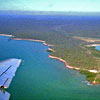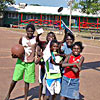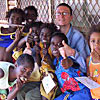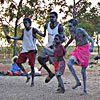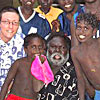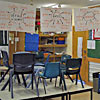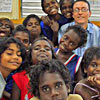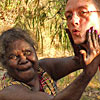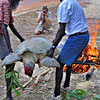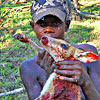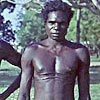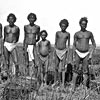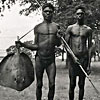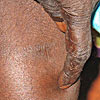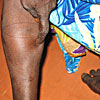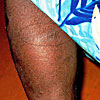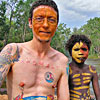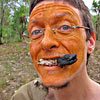
Traditional Body Modification Among Indigenous Australians
Introductory Note My friend Ferg (who most of you know as iam:bizarroboy) recently finished an extended teaching tour in a rural Aboriginal school in Gapuwiyak in northern Australia. As well as living and teaching in an indigenous community, he was able to do this interview with Bentley James, an anthropologist doing work in the region, about traditional scarification, subincision (note: link contains graphic photos), and other rituals of the local peoples. Thank you to Ferg for sharing that interview with us. -Shannon |
By Ferg
HISTORICAL BACKGROUND
Historians now believe Indigenous Australians and Torres Strait Islanders (who lived on the islands between Australia and Papua New Guinea, in what is now called the Torres Strait), have lived there for more than 60,000 years. Estimates of the Aboriginal population in 1788, when the first fleet of European settlers arrived, vary from around 300,000 to one million. The people lived in hundreds of groups, each having their own language. You can see a full map of Aboriginal Australia here.
All land within a recognised traditional area, usually divided by geographical boundaries like rivers, lakes and mountains, was held or ‘owned’ by a ‘clan’ (a cluster of families with special kinship traditions). While some customs were shared across Australia, there were many individual differences depending on the region and the local environment.
Over thousands of years, the people had adapted their way of life to be in harmony with the land and resources around them. A key element of life was sharing which strove to empower the whole community, not just the individual. Food, skills in hunting and gathering, social relationships, spiritual links with the land and special knowledge of laws and sacred places were shared and passed on by each generation through story telling, song, dance and art. No text was ever developed.
Captain James Cook first spotted the east coast of Australia in 1770. He sailed into Botany Bay (in the SE suburbs of what is now Sydney) and selected it as a suitable place for British settlement. His impressions of Aboriginal society were recorded in his journal:
“[T]hey appear to be some of the most wretched People on earth; but in reality they are far happier than we Europeans ... They are unaware of the conveniences that are so much sought after in Europe. They live in a tranquillity which is not disturbed by the inequality [between the rich and the poor] ... The earth and the sea of their own accord furnish them with all the necessary things in life ... They do not desire magnificent houses and live in a warm and fine climate, so that they have little need for clothing.
... [M]any to whom we gave cloth, etc., left it carelessly upon the sea beach and in the woods as a thing they had no manner of use for; in short they seemed to set no value upon anything we gave them ...
This, in my opinion, argues that they think themselves provided with all the necessaries of life.”
Cook claimed ownership of the land for the British and observed that the Aborigines did not farm the land or place fences around it. The British government declared the land ‘terra nullius’ — land owned by no-one — and believed this gave them the right, as the first Europeans to occupy the land, to claim ownership. This meant that all land became Crown land and all Aboriginal property rights were ignored.
Across Australia, the arrival of the Europeans in the 19th Century had a disastrous impact on Aboriginal people. Traditional food hunting and gathering sites were taken over, European diseases caused thousands of deaths and, in many areas, violence broke out when the Indigenous population realised that the Europeans were invaders. They tried to defend their rights and beliefs but had no hope of defeating the well-armed Europeans. Many thousands of Indigenous people lost their lives. Colonial governments established reserves where Aborigines would be ‘protected’ and ‘segregated’ from Europeans. Many of these were missions sometimes brutally controlled by churches and the missionaries that lived there. Even today many still have a very Christian, religious feel to them.
One man, Donald Fergusson Thomson, stood out from all of that when in the late 1920’s and early 30’s he went to live with the Aboriginal people in NE Arnhem Land (a large area of land east of Darwin, in the Northern Territory). He ultimately ended up fighting vigorously for their rights against the dominant, white, self-appointed, colonial Government. He was duly given unfettered access by the Aboriginal people and consequently took over 10,000 photos documenting every aspect of Aboriginal life and culture.
Above, left to right: 1. Flying towards the island. 2. Some of Ferg's students at the island school. 3. Some of Ferg's younger students outside the school office. 4. Some ceremonial 'bungal' dancing. 5. Ferg and his adopted Aboriginal family.
Ferg has also lived and worked with Aboriginal people in NE Arnhem Land: once on an island community for five weeks in 2004 during his Post Graduate Diploma in High School Education and then again when he accepted a two year teaching contract in 2005 to teach Primary children aged between eight and eleven years old at a remote mainland community school. It was during this time that he worked with an established Australian anthropologist called Bentley James whom he struck up not only a good friendship with but also a close working relationship too.
Ferg’s own interest in scarification prompted him to explore the ritual and ceremonial aspects of the local Indigenous people’s visible scars.
Above, left to right: 1. Ferg's classroom. 2. Ferg's second group of students. 3. Ferg being traditionally welcomed to his Principal's family homeland. 4. Large turtle being put on the fire for cooking. 5. Some of the kids being taught how to hunt.
Ferg: Good morning Bentley. Can you first tell us who you are and why it is you do what you do?
Bently: My name is Bentley James. I’m an anthropologist currently writing up my PhD, studying first of all in the central desert region of Australia with the Warlpiri people of Yuendumu and then later coming up here to NE Arnhem Land to work with the Yolgnu people.
As a young fella both my brother and I were influenced by the experience of coming into contact with anthropologists who had experience of living with Aboriginal people from all over Australia, and the sorts of stories that we heard about them and their adventures. Where they’d been and what they’d done all proved an inspiration too powerful to ignore. Consequently we have both spent decades living in remote Aboriginal communities.
Did these anthropologists work only with the Yolgnu people?
No, they worked with people all throughout Australia. Some of them did a lot of work in Western Australia and the desert, then later my brother and I went off to the central desert to work with the Warlpiri people there at Yuendumu at which time I worked mostly in language whereas my brother primarily in the field of art. It’s really all to do with understanding the cultural complex as I worked there in the area of visual anthropology first and then later in linguistics and then later again in education and now continuing in anthropology and writing papers on stuff I’d done over the years in NE Arnhem Land. For the last twelve and a half years I’ve worked solely in NE Arnhem Land in Yan-nhangu languages and before that working in Galiwinku (commonly known as Elcho Island, a small island community off the northern most coast of the Northern Territory) continuing my writing in visual anthropology and most recently just finishing off a dictionary in Yan-nhangu language translated into Gupapuyngu and English, that will be published internationally within the next year or two we hope.
And what exactly is your PhD going to be about?
That’s about the anthropology and ethnography of the Yan-nhangu: mostly about the economic, ritual and social institutions and the transformations of relations of Yan-nhangu life and their relations to the sea.
Can you explain what you mean by ‘Yan-nhagnu’?
Yan-nhangu is a language group of Yolngu people and is the most northern Yolngu language. However they live on the most western of the Crocodile Islands in North East Arnhem Land. Yolgnu is a term used by the people here in NE Arnhem Land to describe themselves and they have about eight different language groups, all of them based on the idea of the proximal demonstrative: so a group might call themselves Dhuwal speakers if they use the word ‘dhuwal’ to describe ‘this’ or ‘here’.
Yan-nhangu people use the word ‘nhagnu’ to describe ‘this’ or ‘here’ and the word ‘Yan’ is ‘tongue’ so literally the language of ‘this’ or ‘here’, so it is really literally and metaphorically the name of the language for here, this place and its language, Yan-nhangu, that’s the kind of study I’m doing at the moment.
If you could boil it down to simpler ideas, what do you find most interesting about this particular group of people here in NE Arnhem Land?
Personally I’m most interested in the religious life of NE Arnhem Land people. The underlying ideas and assumptions about the world that make a particular Yolgnu perspective; what is it that makes it something different to that which exists elsewhere. The particular cosmological plan of the universe, its intricate linkages, its beautifully elaborate ritual con-substantiations of sea, country and land wangarr (ancestor /creator /spirits) essences, a ritual religious animism that has a particular quality linked to locality, land and sea that makes it a very locality based perspective and gives it its particular genius and connectivity and makes it so sensible, so appropriate.
From an outsider’s point of view, the Aboriginal people up here are known to have a very close connection to their land but also a really strong and complicated family and kinship system, much more so than say Western culture. Can you elaborate on that at all?
Above, left to right: 1. Male chest scars to show 'toughness'. 2. Group of older males standing (some chest and arm scars visible). 3. Small boy large chest scar. 4. Hunting stingray (note visible chest scars).
Certainly it’s much easier to explain in their own terms, and as that may make sense or not they consider a number of parts, I would say it’s about five parts that make up the central core of ideas related to ritual con-substantiations of wangarr essences, so they would be... ah... where to start... and that is perhaps:
The world is underlain by a ritual religious assumption, based on ancestral precedent, but parts of them, the ancestors are often described as being in or having left essences, traces in the landscape, for example the word ‘Luku’ or ‘foot’ and that is all of the things to do with ‘Wanga’: ‘home’, ‘ground’, ‘land’, ‘ngrrunggitch’ charcoal or metaphorical ‘hearth’ or the ‘fire’) this is the traces left in the ground that relate to your father’s country and your essential relationship to places of patrilineal association, through your father’s line.
Then there is mother’s relations, matrilineal these are ritual kin relations particularly with land and traces of your mother’s clan that’s called ‘Ngandi pulu’, that describes the kind of connubiality, marital relations, the relationship between people and country of your mother’s group, where a man will find a wife and have responsibilities to look after that country and religious paraphernalia of his mother’s group.
Then there’s ‘Gamanunggu’: mintji, clay painting, colour, the arts, those kinds of things and its relationship to sites and people, painting in ceremony on bodies on the ground, images belonging to particular groups and signifying ancestral connections; a vehicle for conveying symbolic information about nature.
And then there’s paralinguistic sounds in ritual, and, then there’s ‘Matha’: ‘language’ or ‘dark’’ (words) and its relationship to particular country, assigned by the ancestors it is the linguistic bequeath of the wangarr that defines place and belonging, and understanding deep knowledge of place.
Lastly there’s ‘Manikay’ which is songs and ‘bungul dance’: all of the songs and ritual poetry and their musical connections to land and identity, dance movement and signification share a more easily transparent relationship to the deep relations of people to country and kin, the function as a sort of emotions experience and vehicle for transformations through life, although whole theses have been written to explain the smallest part of these things and well, it is complex and beautiful, but too rich for us just now... anyway those five parts, roughly then make up the five perspectives inside the ritual assumption of the people about their relations to the world here, although with far denser meanings attached and much greater ambiguity than I have hinted at, and also it must be said that very few Yolngu would articulate this stuff about ceremony and land in the way that I have from some spaceship-like meta-perspective drawn from my anthropological standpoint, however you will have to ask other Yolngu people to explain their exact meaning for each person for only they can really explain their place.
Would you say then that they have many more rituals and ceremonies than one would say Western culture has, if you can have such a thing as a homogenous group called ‘Western Culture’?
Yes, it’s very hard to count the differences between apples and oranges but in this case they do have an extraordinarily complex ritual life and ritual takes up very much the majority of daily activity because it is linked to essentially every economic and relationship task relating to every meeting, to every ‘hello’ and to actions as simple as cooking, going to places and looking after familial obligations and is referred to in linguistic categories and everyday speech in all kinds of ways. The cooking and sharing and domestic rituals surrounding the hunting, visiting country and other processes of, let’s not get too animistic here, but there are ways of being in country that are not just instrumental trips to glean resources. There is a conversations of sorts going on, without getting too crystal swinging, people care for their environment chiefly through ritual. So with here and in the desert communities there is a very strong connection to the ritual, ceremonial and religious condition.
So a big part of that and essentially what I’m more interested in, are the sub-incision and scarification areas. Let me ask you, do all Australian Aboriginal people practice sub-incision or is it just a small group?
I suppose we should preface our remarks by saying that the ceremonies attached to sub-incision are for the most part completely secret and only for the initiated, so the sorts of things that we’ll discuss are those non-secret parts of it. There are definitely areas that it is practised and areas that it isn’t but the general sort of regional layout of sub-incision ceremonies is throughout the central desert and those practising cults connected with the ‘Warlpiri’ kadjarri ceremonial complex, which it is commonly known as in the language of the centre, but it also travels up to the Northern Territories’ coastal regions around Borroloola and towards Queensland and back towards Western Australia, all the way to the coast and getting up to the NW coastal area near Broome. So it does cover a very, very large area, thousands and thousands of square miles of country and lots and lots of different language groups. Connected intimately with the kangaroo and its travels through country it is very important to those groups who practice it. Scarification however is Australia wide, certainly the beautification kind of cicatrices that you see (‘cicatrix’ is new tissue that forms over a wound and later contracts into a scar) although not practised widely today but very, very widely practised in the past. They are certainly still practised in certain remote area communities today though.
You said ‘beautification’? Are these separate from ritual scars then?
No, certainly some of them are induced particularly to identify with different kinds of relationships, and kinship related parts of the body during different kinds of ritual, so for instance, those rituals carried out like mortuary ceremonies have scarification attached to them, so when a particular cousin dies you scar the part of your body that coincides with the place on your body ritually connected to that person. In the desert particularly, the men will scar their thighs with a sharp object and that’s a sort of sympathetic blood-letting; the scarring that goes with all sorts of mortuary ceremonies are connecting those of close kin. Women at the same time will scar their heads and sometimes women and men will both do their forearms as part of the ‘sorry’ business, but this is different to say how mothers scar themselves at circumcision time.
You mentioned scarring their heads: is that the same as when women, in heightened states of grieving, usually immediately after someone has died, will beat their heads with rocks, tin cans, anything hard and sharp that comes to hand?
So it’s also ceremonial in the fact that this is a very public action, in a public domain if you will, an open visible act of grieving.
I’ve heard that this was done to show that the family of the people close to the person that had just died have nothing to do with ‘black magic’ practises; the letting of blood showed that the person was not a witch or equivalent in that culture?
No, not really. Well, very vaguely but probably could be described more accurately as mortuary rituals. They usually have three parts:
The first part is the covering in white clay, the sounding of noises, the public demonstration is about the idea of shooing away or keeping away of evil spirits, the spirit of the dead person, the less socially acceptable part that gets shooed away, off to the ‘island of the dead’ or wherever it is they go depending on which group you are talking about and that’s scaring away the bad spirit part. He gets shunted off to the deep forests to become a ‘mokoy’ and join the other ‘mokoys’ (ghosts).
Then there’s the second part of ritual singing for the continuing journey of the proper soul part of the spirit, the good part, the patrilineal part through its life journey back to its resting place, its final water hole, its ‘bone ground’, Yirralka, home well, the place where it originated from, the place from where it was found and impregnated the mother, actually not the gapu malthunawuy, conception site although that can be referred to, its the patrilineal homeland, the place of the father’s and grandfather’s bones, the Ngurrungagabo, the ones that came before, ancestors’ country.
And the third and last part is the kind of recombination and grieving at the loss of a part of the kinship network and a sign of people together in grief, their kinship relations and a reaffirmation of their connectedness and oneness and sharing of their grieving.
So that’s the three major parts: shooing away the bad bits, sending the good bits home and all coming together to celebrate our reconnection in a ritual way.
So what part does the head bashing and scarring play in that?
There are a number of aspects to it but one of the key parts is by physically hurting the body you create a situation by where as you heal and the pain goes away, so too the emotional pain of that load goes away. Once the cut has healed over then the relationship to that particular ceremony has closed and you go on to the next social action.
An older woman's leg scar
That’s a similar justification or reasoning I’ve heard in the past for people who harm or cut themselves in Western culture.
Right. That certainly makes very good sense as a simple reflection of the human animal psyche; the humanness of the understanding of emotional pain and physical pain having some very strong brain-mind link. There’s definitely some relationship there between hurting the physical ‘you’ and the healing of the physical ‘you’ and the emotional body being a vehicle for emotional catharsis and physical signification of a particular time, relation, social action, a way of healing and of marking the transitions.
So to go back to what we were talking about before, what is the purpose, that you know of, of sub-incision?
The best way to think about sub-incision is in the wider ritual and religious relations of Aboriginal people to land. There are a number of aspects: firstly one of the things that people are doing when they are carrying out ceremony is that they are increasing the fecundity of the environment. That ceremonial stuff is to produce a productive environment, working to ceremonially reinvigorate the world which has economic aspects, familial aspects and human relations aspects. However it is a man’s domain, and since men don’t have babies it is necessary, and one does not have to be Freud to see that men are usurping the female reproductive capacity through ceremony to control the re-fecundification of people and land. So like circumcision, sub-incision is related to ideas about male responsibility to make the world fertile, but that’s as much as I know on this subject.
So there are many different kinds of ceremonies where these fertility aspects are prevalent, certainly the kankiya, or up, non-secret, non-inside ceremonies in Warlpiri country like Jardiwarinpa, or Janganpa are about public displays of relational aspects and fecundity. For instance here in NE Arnhem Land, the first and most important ceremonial graduation, the first step up the ladder of what is called ‘the long hard road’ in the desert communities of ceremonial rights of passage, is the circumcision ceremony and although not all groups in Australia practise it, it is widely practised and it’s the first in the line for a young man to be ready to become part of manhood. He goes through a ceremony where he is circumcised , he is covered in red ochre and reborn into the company of men through a ritual, then all of the people inside his group see it as a social fact, his manhood, and also go through some kind of ceremonial sympathetic scarification. So for instance, his mother’s mother, his ‘Mari’, she will scar herself; his father’s sister ‘Mokul Bapa’ will also scar herself with a vertical cut on the deltoid/top of the arm and that’s also the site on her body for the hand sign that signifies that relationship (Australian Aboriginal people have a wide range of hand signs or signals that are incorporated into everyday communication which allow them to refer to it without speaking, just by touching a certain part of their body).
Similarly the man who helps the young man through this ordeal of circumcision, his sisters will cut themselves on the side of their buttock to show their relationship. The ‘Yapa Miri’, the young man’s sisters will cut their calves; the mothers and the sister’s daughters ‘Waku’, relationship, the mothers will cut their stomach horizontally; the ‘Mari’ will cut themselves along the side of their ribs and so too the father’s sisters and mums. I think that’s about it but they all do a sympathetic blood letting or used to, its not as common now, but some still do, it depends on where and when these days.
The same sort of thing happens in the desert. The circumcision is the first and most important one. No women are involved in that in the desert as opposed to up here in NE Arnhem Land where women are closely involved in it. In the desert the women are chased away with flaming brands and the circumcision goes on with other ordeals and the young men are taken to a secluded place, a symbolic womb, they crouch there all night, mothers dance around them to make plain the symbolism that allows them to pass from their stage being reborn, when they become men, born by men’s knowledge. But then when they go through the ceremony of sub-incision it’s the next step, like they call it high school, in becoming a man, and usurping the female the power of fertility, now ceremonially men’s. The sub-incision ritual establishes relations with mother’s group and connubial relations; you are sub-incised by men who are standing in special relationship to you, who will give you wives. This will allow for your own reproduction and the carrying on of your gene line. They also form strong relationships with men’s continuing power over fertility in the sociological sense.
Above, left to right: 1. Ferg and one of his students after some mutual body painting. 2. Ferg with the head of a recently hunted and cooked iguana in his mouth.
Do the colours used to paint the body during these kinds of ceremony have any special significance?
Yes, it’s been discussed quite widely that the three conditions of fertility in the psyche of Aboriginal groups are described in relations of colour.
So, the red colour is the colour of blood or the womb and the reproductive activity of women — that belongs particularly to women.
Whereas yellow is the colour of fat, the colour of honey, or the egg yolk, the potential for energy, enhancing the conditions for the possibility of reproduction.
Then the white colour is male, the colour of semen. And white of course is the colour of bone, too, male gamete or bone, the patrilineal part of the reproductive action but blood is definitely the feminine part. So they have, those men in ceremony, like women, the potential to bleed, the potential to encompass all of the parts of reproduction: the representation of red, yellow and white. The colours that symbolise the potential for reproduction, now it does not require feminine participation, its men’s business — it’s held by men.
In the sub-incision ceremony, the men who are going to do the ceremony, stand in relation to the young man who is going to be initiated; they stand in the mother’s group: Jambardi, classificatory: Mother’s Brother. The mother’s brother is the one who performs ritual relations of that kind and is also the one who provides a wife for the initiate. So there is a ritual kind of fertility relationship between a male mother’s group and a male children’s group. It’s essentially a symbolic usurpation through representative actions, ceremonial actions, initiative actions using colours, dancing and songs... but it’s very secret business that does not involve women at all. So for instance any of the secret stuff attached to it which we haven’t discussed has no feminine stories attached to it, women just don’t know anything about that.
In the desert AND up here in NE Arnhem Land?
Well with circumcision ceremonies in which the young men are passing over into the male sphere, the women bash themselves on the head and in the appropriate women-person relationship the women will cut themselves in mourning. It’s as if the sympathetic blood letting is in some way like them saying goodbye, through the passing over of the young man, like a death of his relationship within the female camp of ladies and children into the men’s world. He dies then is reborn through the male ceremonial institution.
So who cuts the women in these circumstances? Do they cut themselves?
Can they cut each other?
Yes they will usually cut themselves but they can also cut each other. They are usually sisters but often relatives will cut each other too.
Most of these scars are attached to rites of passage, kinship and environment etc, are there many done purely for beautification purposes alone?
Oh yes! There is scarification done for all sorts of purposes, not just beautification but for many other things as well. I know lots and lots of friends in the desert who have scarred themselves terribly, to show for instance their... when they’ve been caught out by partners who have accused them of being naughty, they will scar themselves and hurt themselves terribly and lie down on the flaming hot grill on the fire to simply prove their fidelity. There is lots and lots of scarring going on for all sorts of purposes not only for beautification.
There’s a tradition in some desert groups of fighting and stabbing each other around the shoulders and chest, not only of course to achieve the purpose of winning over the opponent in a redoubtable bout of hacking and scraping but the scars that are produced are seen as a symbol of one’s capacity as a strong fighter and one who can stand incredible pain. This toughening up of men starts after initiations when the father’s brothers have the right to hit these young initiates once a day, to stop them being soft, wimps or mummy’s boys. Young ladies in the desert often burn themselves with various kinds of things, on the arm and forearm with cigarette burns and so forth to show how impervious they are to pain and how tough they are; this helps to show where they stand in the status of their group. But there are beautiful scars as well on the neck and arms and chest and so forth, all over the body in fact that make young ladies and young men look more attractive in the eyes of the other people inside their culture.
Is it primarily cutting scars or do they practice branding as well?
Certainly branding. Certainly cutting. Those are the two most prevalent methods, yes.
So have they actually practised branding, for ceremonial purposes and beautification purposes?
For ceremony, I don’t personally know of any incidences of that but definitely for all those other purposes we’ve just discussed.
I just have one more question, not necessarily related to scarification but more generally to do with the global cultural complex.
Some people would argue that taking one part of another culture’s sacred ceremonial behaviour, in this case sub-incision but in other more popular cases, the hook suspension taken from native American cultures, is akin to cultural appropriation. They see this as disrespectful and actually call it a bastardisation of traditional cultures’ secret and sacred ceremonial behaviours.
From your experience with the Australian Aboriginal people in the desert and NE Arnhem Land, what do you think they would make of something like this, that there were lots of white guys running around sub-incising themselves?
I don’t know how good I would be at interpreting how they might feel about that without actually asking them personally and that would be the way to go... but my OWN feeling is that the cultural appropriation of styles and ceremonies and ways of doing things is totally legitimate in a continuing human interest way; we’ve always done that and that’s just the way humans are and how we construct that within our groups and how we talk about those things is part of the negotiation of the human condition. Humans have always taken what was useful and appropriate to us from others, that is the way cultures spread.
So in my opinion it’s a perfectly and absolutely legitimate activity on the behalf of the people involved, as long as those people are not going around pretending to be something that they are not then they are being true to themselves and their business, and that’s their business, and people in the desert would just think that’s their business. Any way they know us white guys are weird.
How people in the desert would feel about it if you were to tell them that it was going on, I don’t think they would be particularly perturbed or surprised at all, again they know we’re all mad.
Any Aboriginal person who is doing this kind of ritual is doing something that is highly specialised and highly defined part of an interlocking cultural space. What other people are doing in their space is different stuff, so other people practising that kind of thing in other places wouldn’t really be particularly affronting. I mean I don’t think what people are doing elsewhere is trying to undermine what people are doing here and I don’t think they would really see it that way unless you put it to them that way. I think they would see it as an interesting reflection of what people do elsewhere but then again you’d have to ask people themselves exactly what they think. How you ask them and how you put it to them would be an important contribution in how they talked about it. My views are just speculation and of course, just my own opinion.
It’s been great talking to you Bentley and best of luck finishing that PhD on time.
Thank you very much for your time.
Thank you Old Chap. It’s been my pleasure.
Click here to comment on or discuss this article
Afterword
For those interested in learning more about the Australian Aboriginal people and Donald Fergusson Thomson’s attempts at documenting their lifestyle, rituals and ceremonies you can read his amazing books with outstanding photographs and also watch a film about this great man called: ‘Thomson of Arnhem Land’
http://www.imdb.com/title/tt0267023/
‘Thomson of Arnhem Land’ tells the story of Australian anthropologist, photographer and journalist, Donald Thomson and his lifelong struggle for Aboriginal rights. Beginning in the 1930s, the film documents Thomson’s passionate interest in Indigenous culture. It follows his journeys through Arnhem Land and explores his relationships with the great clan leader, Wonggu, and his friend and guide, Raiwalla. The story reveals his professional battles and traces his fight to preserve Indigenous culture under threat from assimilation policies that demanded Aboriginal people must become like white Europeans. Thomson of Arnhem Land also gives us an insight into the personality clashes and politics behind the assimilationist policies that aimed to deny Indigenous Australians their culture.
You can also download a sample chapter detailing some of Thomson’s work and photography here (after scrolling down to the bottom of the page):
http://www.assa.edu.au/Publications/dt.htm
Or read a little more about him here:
http://en.wikipedia.org/wiki/Donald_Thomson
Lastly, a film called ‘Ten Canoes’, inspired by one of Donald Thomson’s most famous photographs and filmed in a remote community called Ramingining (near where Ferg worked), was released to much acclaim in 2006, not just for its cinematic beauty but also because it used solely local Aboriginal people as the actors. You can read about it and order the DVD here:
http://www.tencanoes.com.au/tencanoes/
Ferg is a teacher. Born and adopted in Scotland. A sperm donor. Addicted to traveling the globe, writing and meeting people. During the last five years he has lived and worked in Scotland, Venezuela, South Korea, Japan, and Australia. He eats spiders, climbs mountains, drinks beer, takes loads of photos and collects out-of-body experiences. Coming to a town near you... For bibliographical purposes this article was first published online July 16, 2007 by BMEZINE.COM from Toronto, Canada. Interview conducted December 2006 in Gapuwiyak, NE Arnhem Land, NT, Australia.
